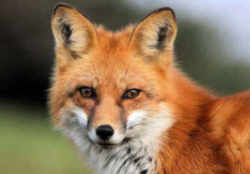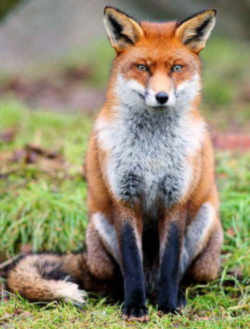
Mississippi Symbols
Mississippi State Land Mammal
Red Fox

(Vulpes vulpes)
Adopted in 1997.
The red fox, (Vulpes vulpes,) was adopted as Mississippi's official state land mammal in 1997. The red fox (Vulpes vulpes) is a member of the canidae family (includes wolf, coyote & domestic dog). The American red fox was previously depicted on a stamp (Scott 1757g) on the Capex '78 souvenir sheet.
Mississippi State Land Mammal: Red Fox

The red fox looks like a small dog with a long, pointed
muzzle, long legs, large, pointed ears and a long, bushy tail. Total length ranges from 36-46 inches. Body weights vary from 8-15 pounds. The fur is
usually reddish-yellow on the sides and slightly darker on the back. Its tail is nearly the same color as the sides but mixed with black and usually
tipped with white. The cheeks, throat, and belly are whitish but the legs, feet, and backs of the ears are black. The pupils of a fox's eyes are almond-shaped
rather than round.
Red foxes aren't always red. Genetic mutations can cause different color phases which are common enough to have their own names. Silver foxes are black
frosted with white, black foxes are black, and Cross foxes have a dark brown band down the back and across the shoulders. "Samson" foxes have a woolly
coat without guard hairs.
Characteristics of the Red Fox
Distribution & Abundance
Red foxes are found throughout Illinois but are most common in the northern two-thirds of the state. An epidemic of sarcoptic mange reduced their numbers dramatically in the late 1960s and early 1970s. They haven't recovered fully because of an increase in Illinois' coyote population (coyotes compete for food and will often kill red foxes) and the retirement of the Soil Bank program (which provided good habitat for red foxes by encouraging farmers to convert highly erodible crop fields to grassland). While not as abundant as they once were, red foxes are still common in Illinois. During late spring or early summer, densities of up to three red foxes per square mile can be found in the best habitats.
Habitat
Red foxes use a wide variety of habitats but seem to prefer grasslands and other open areas, especially those along the edges of forests and woodlands. They make use of crop fields, but do much of their hunting in marshes, woodlands, and brushy fencerows. Crop fields that are left fallow and allowed to grow over with grass and weeds are another favorite place to look for food. Reports of red foxes in urban and suburban areas seem to be more common in recent years, probably because coyote numbers are low and rabbits and rodents are abundant in these areas.
Habits
A fox's dense fur allows it to curl up on the open ground and stay warm in even the coldest weather. It's tail is used to cover its nose and feet.
Red foxes rarely use dens except while raising their young. Burrows dug by woodchucks, badgers, or other animals are the most common den sites. They
seem to prefer burrows located on the sunny side of a hill in a grassy field, along a fence row, or in a wooded area. Burrows under abandoned buildings
are also popular. About 20% of the den sites used to raise litters are used two years in a row. Some are used for up to 15 consecutive years.
Most dens have more than one entrance. Entrances are 8-15 inches across and lead to burrows up to 75 feet in length. A chamber with a grass-lined bed
for the young is hollowed out about four feet underground. Bones, fur, and feathers are often found near the den entrance once the pups are weaned.
Some foxes maintain smaller, temporary dens nearby where the pups can be moved if danger threatens.
Red foxes are active mostly at night. If they're seen during the daytime, it's usually late in the morning or early in the evening. They sometimes
travel the same routes over and over, making worn trails. It's not unusual for them to stop occasionally to roll on strong smelling objects like dead,
decaying animals. They do this to cover their scent, making it easier for them to stalk their prey undetected. The fox uses its large, bushy tail for
balance when hunting.
Adult red foxes tend to stay within a mile of their dens while they're raising young, especially if food is plentiful. At other times of the year, they live in an area 5-10 miles across. Males travel farther than females. Juveniles that leave their parents in the fall have been known to travel as far as 100 miles. Red foxes can run at speeds of more than 30 miles per hour when pursued and are good swimmers.
Foods
About 60% of a red fox's diet is made up of rabbits and mice. A study in Missouri showed the following food groups and their percentages by volume: rabbits 35.5; mice and rats 23.7; other wild mammals 9.0; livestock 5.4; poultry 13.6; wild birds 3.3; known carrion 6.1; insects 0.6; plants 2.5; and miscellaneous 0.3. In Wisconsin, major foods included rodents, rabbits, and birds. It is sometimes difficult to accurately evaluate the red fox's food habits since it is often impossible to determine whether the food was secured as a kill or eaten as carrion.
Red foxes eat about one pound of meat at a feeding. They often kill more than they can eat when food is abundant. The surplus is buried or covered with leaves or grass and marked with urine. They might or might not return to eat the food. Some of these food caches are raided by skunks, crows, opossums, or other foxes.
Reproduction
Mating takes place from late December to March, but peaks in January. Females have a short period when they're receptive, lasting just 2-4 days once a year. The gestation period (pregnancy) varies from 49-56 days with an average of 53 days. The single annual litter is usually born in late March or early April. Litter sizes vary from 1-10 with an average of 4-6 pups.
The female, or vixen, chooses a den site for raising her young, but both parents help to care for them. The female stays in the den with her pups for the first few days after they're born. The male, or dog fox, brings food to her during this time. Later she hunts at night and nurses the pups by day. While rare, it's been known for two females to share the same den while raising their litters.
The pups, or kits, are blind, helpless, and weigh about 3 1/2 ounces at birth. Their eyes open at 8-9 days of age. At 4-5 weeks of age, they start spending much of their time outside the den entrance. It's not unusual to see them playing with each other or with leftover bones, fur, or feathers while waiting for their parents to return with food. The parents try to carry off some of the droppings and leftover food, but the area outside the den entrance is often littered and has an unpleasant odor by the time the family moves on.
Pups are weaned and begin taking short trips with their parents when 8-10 weeks old. Some families move to temporary dens or other hiding places like road culverts at this point in the pups' lives. Pups start fending for themselves at 16-20 weeks of age, but don't stray more than 1/2 mile from their den for the next few weeks. By fall, they're fully grown and leave the area where they were raised. Young males travel an average of 25 miles from where they were born. Young foxes can have a litter of their own when about a year old.
Mississippi Law
The law designating the red fox as the official Mississippi state land mammal is found in the Mississippi Code, Title 3, Chapter 3. Section 17
Title 3 - STATE SOVEREIGNTY, JURISDICTION AND HOLIDAYS
Chapter 3 - STATE BOUNDARIES, HOLIDAYS, AND STATE EMBLEMS
§ 3-3-17 - State land mammals
Universal Citation: MS Code § 3-3-17 (2013)
The white-tailed deer (Odocoileus virginianus) and the red fox (Vulpes vulpes) are designated the state land mammals of Mississippi.
Taxonomic Hierarchy: Red Fox
Kingdom: Animalia
Phylum: Chordata
Class: Mammalia
Order: Carnivora
Family: Canidae
Tribe: Vulpini
Genus: Vulpes
Species: Vulpes vulpes







